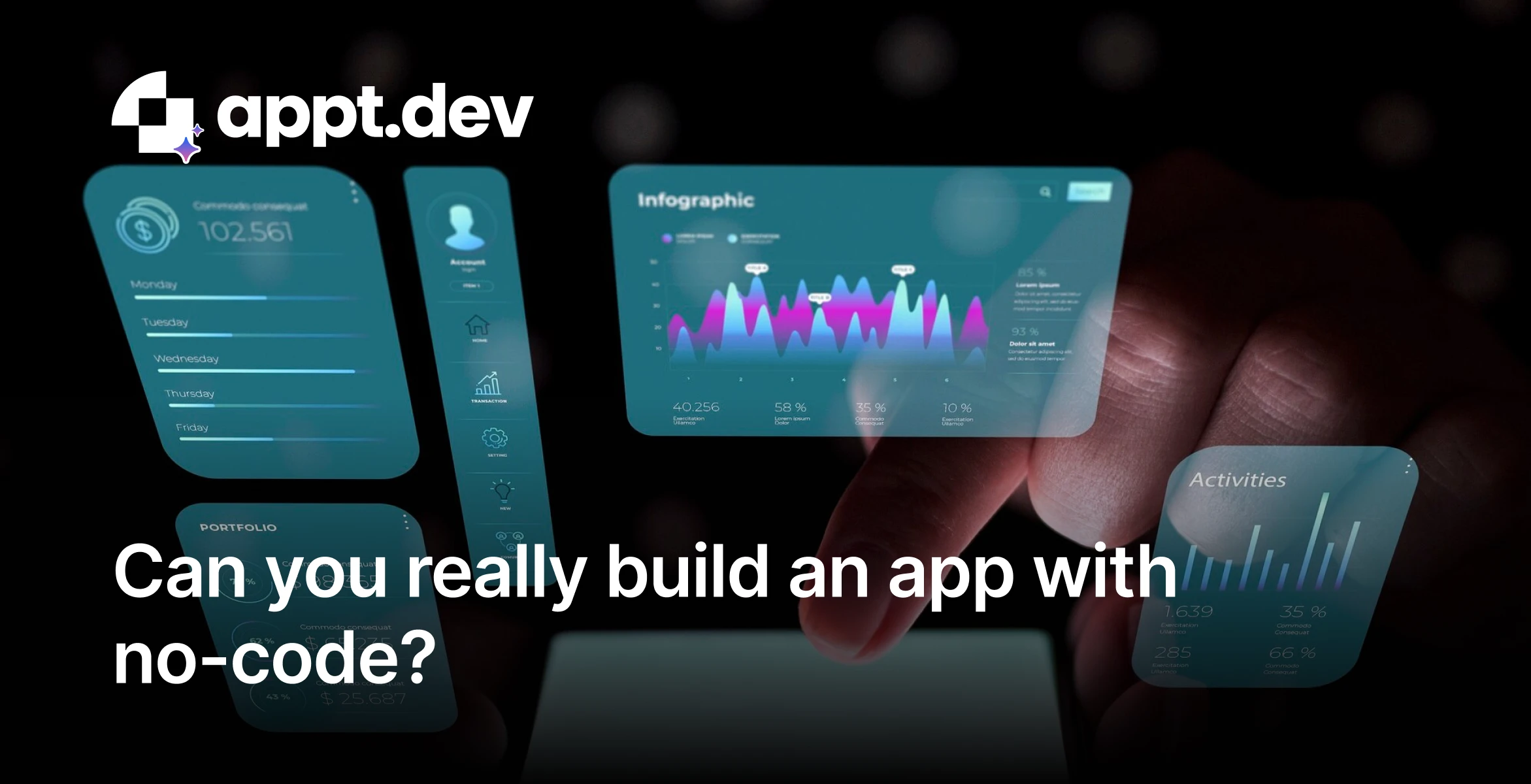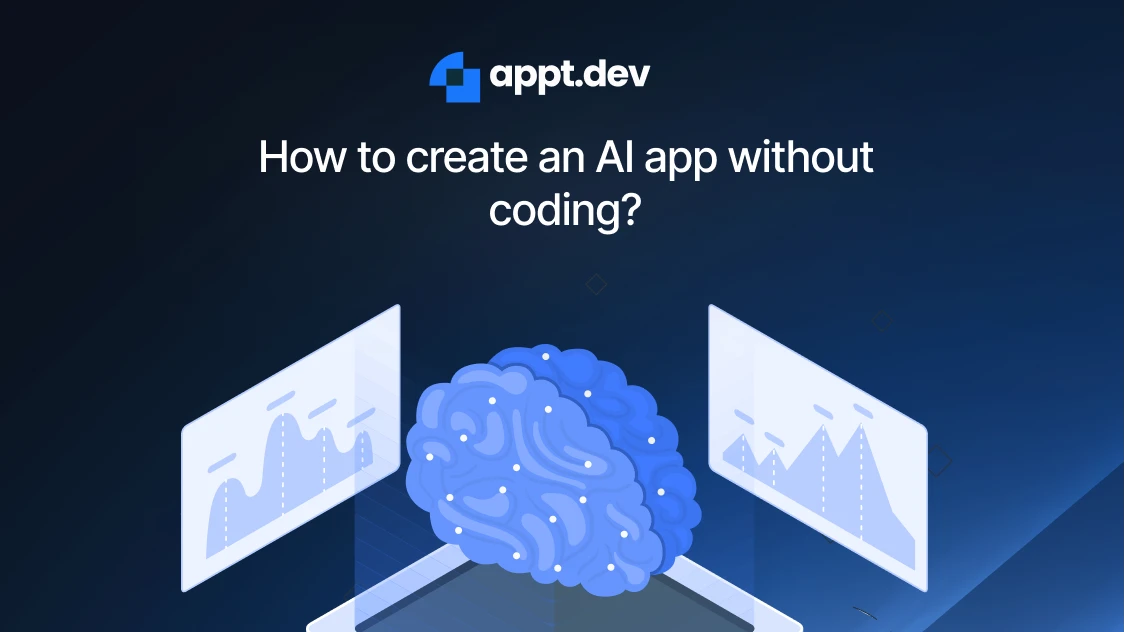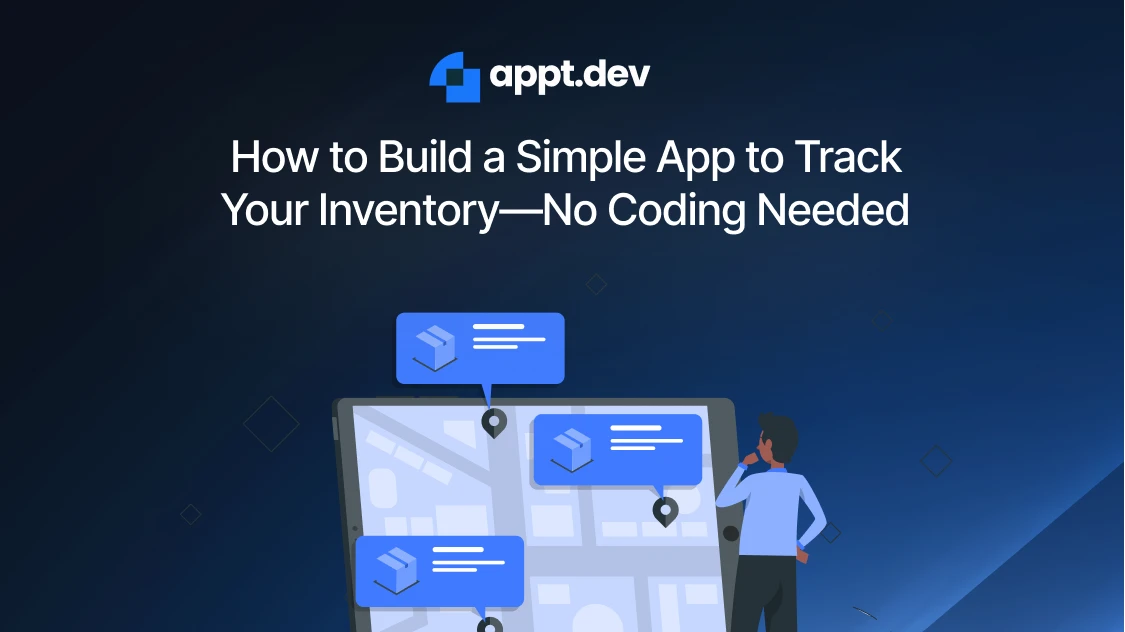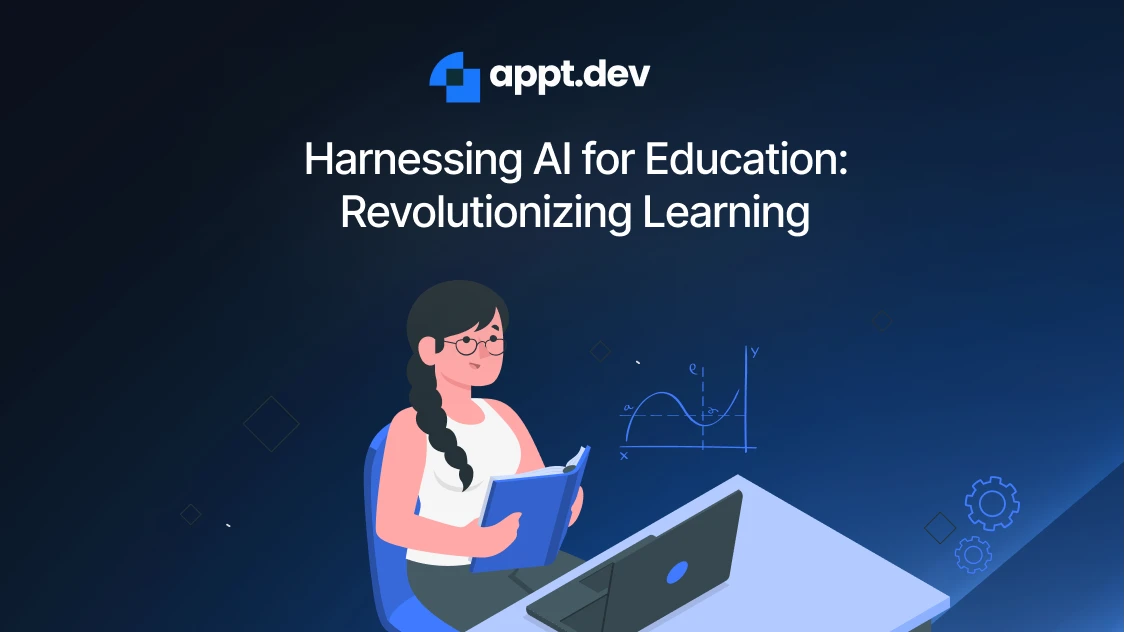Can you really build an app with no-code?
Low-code

Abhijeet Chowdhury
May 24, 2025 | 4 min
Share to

In a world where digital transformation is no longer optional, the ability to create custom applications quickly has become a competitive advantage. But what if you don't have a team of developers or coding expertise? The rise of no-code and low-code platforms promises to democratize app development, allowing anyone to build functional applications without writing a single line of code. But is this too good to be true? Can you really build an app without coding knowledge? This comprehensive guide explores the reality of no-code development, separating hype from reality while showing you what's truly possible in today's no-code landscape.
The No-Code Revolution: Market Growth and Adoption
The no-code movement isn't just a passing trend-it's transforming how businesses approach software development. According to recent market research, the no-code development platform market is projected to reach a staggering $84.47 billion by 2027, growing at a compound annual growth rate (CAGR) of 28.9% from 2020. This explosive growth reflects the increasing demand for faster, more accessible application development methods.
By 2025, no-code technology is expected to power 70% of new business applications, as companies increasingly abandon traditional coding approaches in favor of faster, more user-friendly alternatives. This shift is particularly evident among small and medium-sized businesses (SMBs), which are projected to account for over 60% of the no-code market share. These organizations often lack the resources to maintain large development teams but still require custom applications to remain competitive.
The growth of no-code platforms is also closely tied to the rise of "citizen developers"-business users who create applications without formal coding training. This group is projected to increase by at least 50% , representing a fundamental shift in who controls application development within organizations. This democratization of development is enabling businesses to address their software needs more rapidly than ever before.
Why Now? Factors Driving No-Code Adoption
Several factors have converged to make no-code development more viable and valuable than ever:
- The technical talent shortage: With demand for software developers far outpacing supply, companies are looking for alternatives to traditional development.
- Accelerating digital transformation: COVID-19 dramatically increased he pressure on businesses to digitize operations quickly.
- Rising AI integration: Over 70% of no-code platforms are expected to integrate AI-powered features by 2025, further enhancing their capabilities and accessibility.
- Changing business expectations: Modern businesses expect technology solutions to be implemented in days or weeks, not months or years.
- Increased platform maturity: No-code platforms have evolved significantly, offering more sophisticated features and greater flexibility.
These factors have created perfect conditions for no-code adoption to accelerate, but to fully understand the potential and limitations of this approach, we need to clarify what exactly we mean by "no-code."
Understanding the Spectrum: No-Code vs. Low-Code Platforms
The terms "no-code" and "low-code" are often used interchangeably, but there are important distinctions between these approaches. Understanding these differences is crucial for selecting the right platform for your needs.
What is No-Code?
No-code is a software development approach that requires few, if any, programming skills to quickly build an application, website, or module that links into an existing system1. This enables business users who understand the requirements but lack programming knowledge to create functional applications through visual interfaces, typically using drag-and-drop components and pre-built templates. The primary goal of no-code platforms is to make application development accessible to non-technical users, often referred to as "citizen developers." These platforms abstract away the complexities of coding entirely, allowing users to focus on the business logic and functionality they need.
What is Low-Code?
Low-code platforms, while similar to no-code in many respects, provide more flexibility and customization options at the cost of slightly higher technical requirements. These platforms still use visual development environments but allow for the addition of custom code when needed. They're typically used by professional developers who want to accelerate development without sacrificing control or customization options.
Key Differences Between No-Code and Low-Code
The following table highlights the main distinctions between these two approaches:
| Feature | Low-Code | No-Code |
|---|---|---|
| Primary Users | Developers | Business Users |
| Main Objective | Speed of Development | Ease of Use |
| Coding Requirement | Low, but present | No Coding Required |
| Customization | Total customization available | Pre-built templates can be customized |
| Platform Lock-in | Free to move between platforms | Sometimes locked into the same platform |
| End-to-end Development | All platforms provide end-to-end development | Some platforms provide only limited capabilities |
| Purpose | Next-gen Rapid Application Development tool for SMBs | Self-service application for business users |
| App Complexity | Can create complex apps | Can create simple apps |
| Cost Effectiveness | Cost-effective for companies with a dev team | Cost-effective for teams with high needs and limited dev resources |
Understanding these differences helps clarify the kinds of applications that can realistically be built without traditional coding. While both approaches reduce the need for manual coding, they serve different purposes and user groups. No-code platforms prioritize accessibility and simplicity, while low-code platforms balance speed with greater flexibility and customization options.
What's Possible with No-Code Development?
No-code platforms have evolved significantly in recent years, expanding the types of applications that can be built without traditional coding. But what exactly can you build with no-code tools, and where do they fall short?
Common No-Code Use Cases
According to recent industry analysis, the most common use cases for no-code development include:
- Web application development: Creating landing pages, internal tools, and simple web applications with interactive elements.
- Mobile application development: Building simple mobile apps and prototypes, particularly for internal business use.
- Workflow automation: Automating repetitive business processes and creating approval workflows.
- Data visualization and analytics: Developing dashboards and reporting tools that transform raw data into actionable insights.
- eCommerce: Building online stores and marketplaces with product catalogs, shopping carts, and payment processing.
- CRM (Customer Relationship Management): Creating custom CRM systems tailored to specific business needs.
- HR applications: Developing employee onboarding systems, performance management tools, and other HR-related applications.
The growing sophistication of no-code platforms means that these applications can often rival traditionally coded solutions in terms of functionality and user experience, especially for internal business applications.
Real-World Success Stories
Numerous businesses have successfully leveraged no-code platforms to create valuable applications:
A real estate agency built a custom property management system in three weeks using a no-code platform, replacing a legacy system that had taken six months to develop traditionally.
- A healthcare provider created a patient intake app that integrated with their existing systems, improving efficiency and reducing errors.
- A retail chain developed an inventory management system that synchronized across multiple locations, providing real-time stock visibility.
These examples demonstrate that no-code isn't just for simple, standalone applications-it can be used to build sophisticated solutions that solve real business problems.
Where No-Code Falls Short
Despite their growing capabilities, no-code platforms do have limitations:
- Complex custom functionality: When requirements extend beyond what the platform's pre-built components can provide, no-code solutions may struggle.
- Integration challenges: While improving, integration with external systems and APIs can sometimes be limited or require workarounds.
- Performance optimization: No-code platforms may not offer the fine-grained control needed for applications that require exceptional performance.
- Unique user experiences: Creating highly customized, unique user interfaces can be challenging within the constraints of no-code tools.
- Sophisticated business logic: Very complex business rules and calculations may be difficult to implement without some coding capabilities.
These limitations help explain why low-code platforms, which allow for custom code when needed, are often preferred for more complex enterprise applications. However, for many business applications, these limitations may not be relevant or can be addressed through creative solutions within the no-code environment.
The No-Code Development Process
Building an app without code typically follows five stages:
- Design the Interface
- Templates vs. Custom Builds: Choose pre-designed layouts or create unique interfaces using drag-and-drop elements like buttons, forms, and tables.
- Responsive Design: Ensure apps adapt to screens of all sizes (desktop, tablet, mobile) through built-in responsive tools.
- Build Functionality
- Workflows: Automate tasks (e.g., approval processes, data updates) using conditional logic.
- Data Management: Structure databases visually, similar to spreadsheets, to store user inputs or business data.
- Integrations: Link apps to tools like Slack, Google Sheets, or payment processors via native connectors.
- Test and Iterate
- Usability Testing: Gather feedback from stakeholders to refine navigation, workflows, and design.
- Bug Fixing: Identify and resolve issues through platform-specific debugging tools.
- Secure and Maintain
- Role-Based Access: Assign permissions (e.g., admin, viewer) to control data access.
- Compliance: Ensure apps meet regulations (e.g., GDPR) using built-in security features like encryption.
- Deploy and Scale
- Publishing Options: Distribute web apps via URLs or submit mobile apps to stores like Google Play.
- Performance Monitoring: Track usage metrics and scale resources (e.g., server capacity) as needed.
Common Concerns and Misconceptions About No-Code Development
Despite the growing popularity of no-code development, several concerns and misconceptions persist. Addressing these issues can help organizations make informed decisions about whether no-code is right for their needs.
Misconception 1: No-Code Applications Aren't Secure
Some believe that applications built without traditional coding must be inherently less secure. However, modern no-code platforms often implement security best practices automatically, reducing the risk of common vulnerabilities like SQL injection or cross-site scripting that can occur in hand-coded applications.
That said, security still requires attention. Organizations should evaluate a platform's security features, including:
- Data encryption (both at rest and in transit)
- Authentication and authorization controls
- Compliance certifications (SOC 2, GDPR, HIPAA, etc.)
- Regular security updates and vulnerability patching
When properly configured, no-code applications can be as secure as traditionally developed ones-sometimes more so, as they eliminate certain classes of coding errors.
Misconception 2: No-Code Can't Scale
Another common concern is that no-code applications won't perform well under high loads or with large data volumes. While early no-code platforms did have scalability limitations, modern platforms are designed with scalability in mind.
Many enterprise-grade no-code platforms now offer:
- Cloud-based infrastructure that scales automatically
- Performance optimization tools
- Caching mechanisms
- Database optimization features
However, scalability requirements should still be considered when selecting a platform, especially for applications that might experience rapid growth or usage spikes.
Misconception 3: No-Code Creates Vendor Lock-In
Some organizations worry that adopting a no-code platform will lock them into that vendor's ecosystem, making it difficult to switch platforms later. This concern isn't entirely unfounded-no-code applications are typically tied to the platform they're built on.
To mitigate this risk:
- Choose platforms that export data in standard formats
- Consider open-source options that give you more control
- Document your business logic separately from the implementation
- Evaluate the platform's longevity and financial stability
While some degree of lock-in is unavoidable with no-code platforms, the benefits often outweigh this drawback, especially when the alternative is having no application at all due to development constraints.
Misconception 4: No-Code Is Only for Simple Applications
Perhaps the most persistent misconception is that no-code can only build basic, limited applications. While it's true that extremely complex applications might still require traditional coding, the capabilities of no-code platforms have expanded dramatically.
Today's no-code platforms can support:
- Complex business logic and workflows
- Integration with external systems via APIs
- Role-based access controls
- Advanced reporting and analytics
- Responsive designs for multiple device types
The boundary between what requires code and what doesn't continues to shift as no-code platforms evolve. Many applications that would have required coding just a few years ago can now be built entirely without code.
Legitimate Concerns
Despite dispelling these misconceptions, some legitimate concerns about no-code development remain:
Skills gap: Organizations may lack the process design and logical thinking skills needed to effectively use no-code platforms, even if traditional coding isn't required.
Shadow IT: Without proper governance, no-code tools can lead to a proliferation of unauthorized applications within an organization.
Maintenance and documentation: No-code applications still require ongoing maintenance and documentation, which organizations sometimes overlook.
Integration complexity: While improving, integrating no-code applications with legacy systems can sometimes be challenging.
Acknowledging these concerns and addressing them proactively can help organizations maximize the benefits of no-code while minimizing potential drawbacks.
The Future of No-Code Development: AI Integration and Beyond
The no-code landscape is evolving rapidly, with artificial intelligence playing an increasingly important role. Understanding these trends can help you prepare for the future of application development.
AI-Powered No-Code Development
Artificial intelligence is transforming no-code platforms in several ways:
Intelligent design assistance: AI systems can suggest layouts, color schemes, and design elements based on your content and goals.
Automated data analysis: AI can identify patterns in your data and suggest visualizations or business insights.
Natural language processing: Some platforms now allow you to describe what you want in plain language, with AI translating your requirements into functional applications.
Code generation and optimization: AI can generate optimized code behind the scenes, improving performance without requiring user intervention.
By 2025, over 70% of no-code platforms are expected to integrate AI-powered features, making application development even more accessible to non-technical users.
Emerging Trends in No-Code Development
Beyond AI integration, several other trends are shaping the future of no-code:
Specialized vertical solutions: No-code platforms are emerging for specific industries like healthcare, finance, and education, with pre-built components tailored to these sectors.
Enterprise adoption: Large organizations are increasingly embracing no-code for departmental applications, citizen development initiatives, and rapid prototyping.
Hybrid development approaches: The lines between no-code, low-code, and traditional development are blurring, with teams using each approach where it makes the most sense.
Community-driven components: Marketplaces of pre-built components and templates are growing, allowing users to leverage work from the broader community.
Enhanced governance and compliance: As no-code adoption increases in regulated industries, platforms are adding more sophisticated governance and compliance features.
These trends suggest that no-code development will continue to expand its capabilities and reach, becoming an integral part of the software development landscape rather than just an alternative to traditional coding.
The Skills of the Future
As no-code platforms become more powerful, the skills needed to succeed in application development are evolving:
Systems thinking: Understanding how different parts of an application interact and how to design effective workflows.
Data modeling: Creating logical data structures that support application requirements.
User experience design: Designing intuitive, effective interfaces even without coding skills.
Process optimization: Identifying opportunities to streamline and automate business processes.
Platform expertise: Deeply understanding the capabilities and limitations of specific no-code platforms.
Organizations that cultivate these skills will be better positioned to leverage no-code platforms effectively, regardless of how the technology evolves.
How ApptDev's AI-Powered Low-Code Platform Can Help
In this rapidly evolving landscape of no-code and low-code development, ApptDev stands out as a powerful solution that brings together the best of both worlds. ApptDev's AI-powered low-code platform offers a unique approach that addresses many of the challenges and limitations discussed throughout this article.
The ApptDev Advantage
ApptDev enables organizations to launch production-ready applications in hours rather than weeks or months.
This dramatic acceleration of development timelines can provide businesses with a significant competitive advantage in today's fast-paced market.
The platform accomplishes this through several key features:
AI-powered development assistance: ApptDev leverages artificial intelligence to streamline the development process, suggesting solutions and automating repetitive tasks.
Intuitive visual interface: The platform provides a user-friendly environment that allows both developers and business users to collaborate effectively.
Enterprise-grade capabilities: Despite its accessibility, ApptDev doesn't compromise on the features needed for serious business applications.
Extensibility: When custom functionality is required, ApptDev's low-code approach allows developers to extend the platform's capabilities with code.
Who Benefits from ApptDev?
ApptDev's platform is designed to serve a wide range of users and use cases:
IT departments facing application backlogs can multiply their productivity without sacrificing quality or control.
Business teams can bring their ideas to life without waiting for developer resources to become available.
Professional developers can focus on complex, high-value aspects of applications while leveraging the platform to handle routine elements.
Organizations undergoing digital transformation can accelerate their initiatives with rapid application development.
The versatility of ApptDev's platform makes it suitable for organizations of all sizes, from startups looking to launch their first applications to enterprises seeking to modernize their development processes.
Getting Started with ApptDev
If you're interested in exploring how ApptDev's AI-powered low-code platform can accelerate your application development, there are several ways to get started:
Schedule a demo: See the platform in action with a personalized demonstration tailored to your specific needs.
Start a proof of concept: Test the platform with a small, real-world project to experience its capabilities firsthand.
Engage with the ApptDev community: Connect with other users to share ideas, best practices, and success stories.
By leveraging ApptDev's platform, organizations can combine the speed and accessibility of no-code development with the flexibility and power of traditional coding when needed, creating a truly optimal approach to modern application development.
Conclusion: Yes, You Can Build Real Apps With No-Code
After exploring the capabilities, limitations, and future of no-code development, we can confidently answer the question posed in the title: Yes, you can really build apps without code-but with some important qualifications.
No-code platforms have matured significantly, enabling non-technical users to create functional, professional applications that would have required extensive coding expertise just a few years ago. The growing market for these platforms, projected to reach $84.47 billion by 2027, reflects their increasing value and adoption across industries.
However, no-code development isn't a complete replacement for traditional coding in all scenarios. Complex, highly customized applications with unique requirements may still benefit from some level of coding, which is where low-code platforms like ApptDev offer a compelling middle ground.
The most effective approach often involves using the right tool for each situation:
No-code for rapid deployment of straightforward business applications, especially when non-technical users need to lead development
Low-code for more complex applications that require customization beyond what pure no-code can provide
Traditional coding for highly specialized applications with unique requirements that can't be met by existing platforms
As AI continues to enhance no-code and low-code platforms, the line between what requires code and what doesn't will continue to shift. Organizations that embrace these technologies now, while developing the process design and systems thinking skills needed to use them effectively, will be well-positioned for the future of application development.
The democratization of application development through no-code platforms represents a fundamental shift in how organizations approach technology. By reducing the technical barriers to creating software, these platforms are enabling more people to bring their ideas to life and solve problems that would otherwise go unaddressed due to resource constraints.
Whether you're a business leader looking to accelerate digital transformation, an IT professional seeking to clear your application backlog, or an innovator with an idea you want to bring to market quickly, today's no-code and low-code platforms-including ApptDev's AI-powered solution-offer powerful tools to turn your vision into reality without writing code.
Citations
FAQs
Related Blogs

How to create an AI app without coding?
In today's rapidly evolving technological landscape, artificial intelligence has transformed from an exclusive domain of specialized developers to an accessible tool for businesses and individuals alike.
Read More
How to Build a Simple App to Track Your Inventory—No Coding Needed
Here’s a concise guide to building a custom inventory-tracking app on ApptDev—no coding required. You’ll learn why inventory management matters, how ApptDev’s visual tools streamline every step, and key insights to maximize efficiency. By following our six-step walkthrough, you’ll go from blank canvas to deployed app in under an hour, complete with automated reorder alerts and mobile-ready interfaces.
Read More
AI for Education: Revolutionizing Learning with ApptDev
Education today is confronted with unprecedented challenges. Rapid advances in technology, the need for personalized learning, and mounting administrative burdens demand that educational institutions continuously improve efficiency, quality, and responsiveness.
Read More